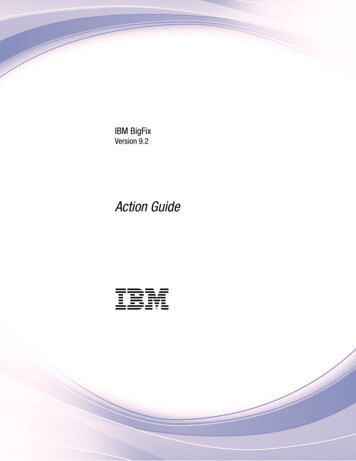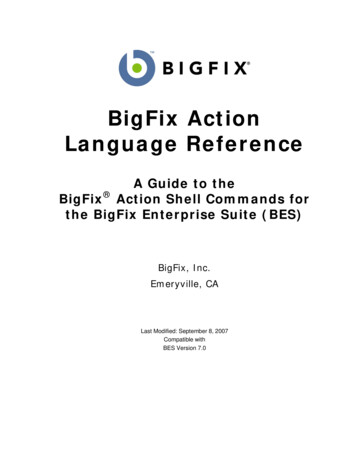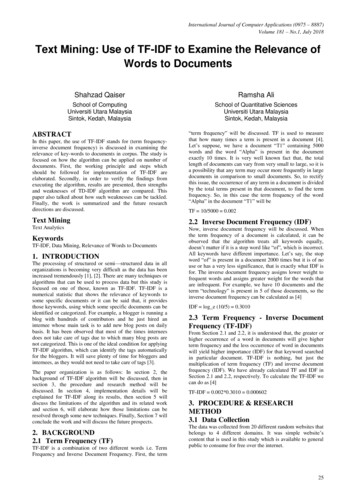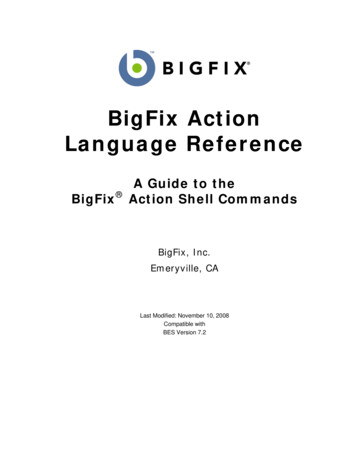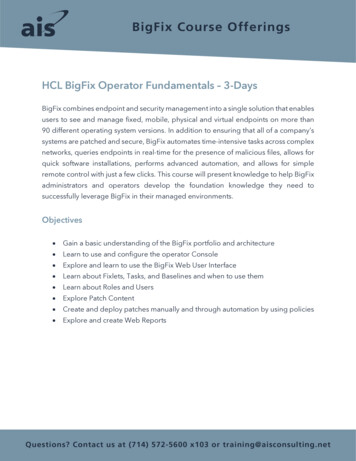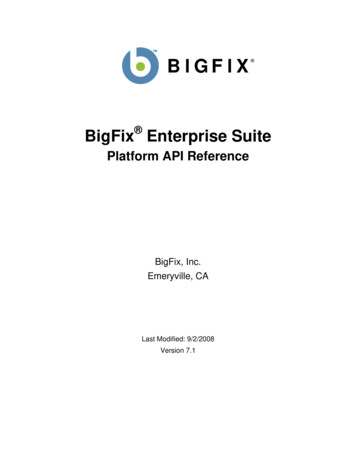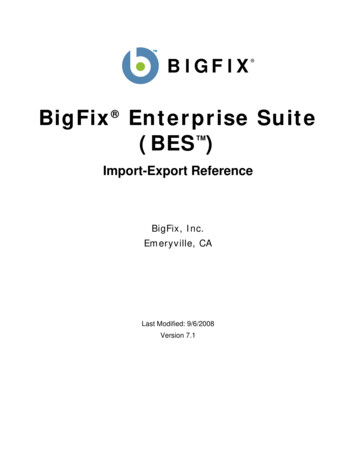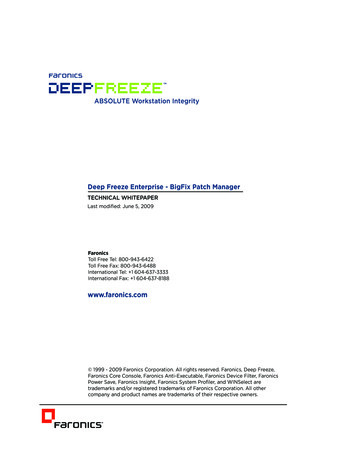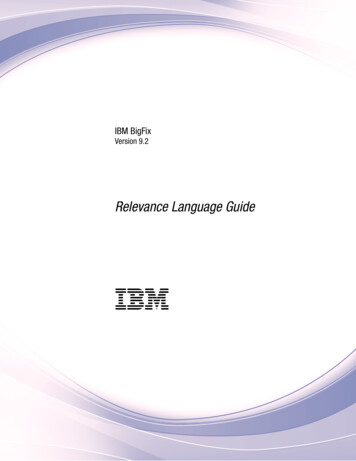
Transcription
IBM BigFixVersion 9.2Relevance Language GuideIBM
IBM BigFixVersion 9.2Relevance Language GuideIBM
NoteBefore using this information and the product it supports, read the information in “Notices” on page 65.This edition applies to version 9, release 2, modification level 0 of IBM BigFix and to all subsequent releases andmodifications until otherwise indicated in new editions. Copyright IBM Corporation 2010, 2015.US Government Users Restricted Rights – Use, duplication or disclosure restricted by GSA ADP Schedule Contractwith IBM Corp.
ContentsChapter 1. Introducing the Relevancelanguage . . . . . . . . . . . . .1The Scope of Relevance . . . . . .Fixlet Debugger on Windows clients .Fixlet Debugger on non-Windows clientsUsing the Presentation Debugger . .2567Chapter 2. Using Relevance . . . . .9Relevance language Overview .Primary Elements . . . .Exists . . . . . . . .Plurals (Collections) . . .Whose - It . . . . . . .Sets . . . . . . . . .Properties and References .Relations . . . . . . .Casting . . . . . . . .Indexing . . . . . . .Tuples . . . . . . . .Plurals with Tuples . . . .Comparing Tuples . . . .Arithmetic . . . . . . .ANDs and ORs . . . . .If-then-else . . . . . .Expressions . . . . . .IBM BigFix Inspectors . . . .Core Inspectors . . . . .Other Inspector Examples .Propagation of non-existenceDetermining Object PropertiesRelevance in Property Analysis .Viewing Property Analyses .Creating Property Analyses .Relevance in action Scripts . .Viewing action Scripts . . .Creating action Scripts. . . Copyright IBM Corp. 2010, 2828282829Useful Relevance Expressions . . . . . . .Using Number Ranges. . . . . . . . .Using the Bar Operator . . . . . . . .Manipulating Strings . . . . . . . . .Substring index of string . . . . . . . .Manipulating Dates and Times . . . . . .Summing Over Time Units . . . . . . .Operating on Lists of Floating Point Numbers .Using Wildcard Searches for Files and Folders .Comparing Versions . . . . . . . . .Inspecting the Windows Registry . . . . .Environment variables. . . . . . . . .Determining Operating System Information .Accessing the Task Manager (Processes) . . .Examining Running and Scheduled Tasks . .Recognizing Office Service Packs . . . . .Detecting Foreign Language Service Packs . .Deconstructing XML . . . . . . . . .Using White Lists . . . . . . . . . .30303132333435363637384041414243444445Appendix A. Relevance languageGrammar . . . . . . . . . . . . .47Relevance Operators . . .Precedence and AssociativityRelevance Key Phrases . .Language History . . . .BES 1.x . . . . . . .Error Messages . . . .484849515153Appendix B. Support. . . . . . . .63Notices . . . . . . . . . . . . .65Trademarks . . . . . . . . . . . . .Terms and conditions for product documentation.6768iii
ivIBM BigFix: Relevance Language Guide
Chapter 1. Introducing the Relevance languageIBM BigFix allows large networks of computers to be easily monitored andpatched in real time using Fixlet technology. A Fixlet inspects a client computerand reports back to central servers. This allows a patch or an update to beefficiently applied to just those computers where it is relevant, and no others. Italso enables the retrieval of various computer properties that can be collected,analyzed, charted and archived.The heart of the Fixlet technology is the Relevance language that allows authors tointerrogate the hardware and software properties of your managed clients usingInspectors. With the Relevance language, you can write expressions describingvirtually any aspect of the client environment. Some Fixlets are simply designed toreturn Relevance information to the servers, but most of them suggest actions thatcan patch or update the client computer. The actions, in turn, also take advantageof Relevance expressions.Fixlet messages and Relevance expressions by themselves can only notify the useror the administrator. Actions, on the other hand, are specifically designed to modifythe client, so there is a clear dividing line between a Relevance expression and itsassociated action – typically a human is required to deploy the action.Dividing the labor in this fashion, using Relevance clauses to benignly inspect theclient and actions to fix them (upon approval), the IBM BigFix applications providean unprecedented blend of both safety and power.Relevance expressions are designed to be human-readable. This allows users andadministrators to examine them before deploying any associated actions. Thelanguage gives you access to thousands of computer properties using Inspectors.The values returned by the Inspectors can be used for calculations andcomparisons, allowing the Fixlet to determine relevance and target a computer foraction.This guide is your reference for the Relevance language. With this guide and theappropriate platform-specific Inspector Guides, you will be able to write Relevanceexpressions that can trigger Fixlet messages. You can learn how to create actions byreading the IBM BigFix Action Language Reference.This reference is for IT managers who want to write Fixlet messages for computersmanaged by the IBM BigFix. The standard IBM BigFix package includes tens ofthousands of pre-packaged Fixlets and associated actions, but you can to expandon these offerings with custom content tuned to your specific enterprise andsecurity configuration.This reference is also for IT managers who want to better understand theRelevance expressions that trigger a Fixlet message. Although the language isdesigned to be human-readable, it is possible to make sophisticated expressionsthat require careful analysis. This will allow users to understand the Relevanceclauses embedded in action scripts as well. Copyright IBM Corp. 2010, 20151
The Scope of RelevanceRelevance is a continuous thread used throughout all aspects of the IBM BigFix.Some of its more important manifestations include:v Evaluating Fixlet relevance. This is the most common place to find theRelevance language and explains how it got its name. As you’ll see in detailbelow, expressions in this language are designed to trigger only when the clientcomputer exhibits a particular state – thus the Fixlet is not displayed unless it’srelevant. You can see the Relevance expression behind each Fixlet in the IBMBigFix Console: click on a Fixlet from the list, then look at the Details tab.You may see more than one Relevance expression; these are all ANDed togetherto form the final expression.v Evaluating Tasks. Tasks are functionally similar to Fixlets and use Relevanceexpressions to determine which computers should be targeted. Whereas Fixletsare designed with remediation in mind, Tasks are designed with continuingmaintenance in mind. The main difference between Fixlets and Tasks lies in howthey are judged to be "fixed". Fixlet actions will report back as fixed when theyare no longer relevant, while by default Task actions will report back as fixedonce all the lines of its action have completed.v Displaying Retrieved Properties. From the IBM BigFix Console, you can retrieveproperties of the Client computers. There are some built-in properties, but youcan also create your own. To see an example, select an item from the Analysestab, then click on the subsequent Details tab.2IBM BigFix: Relevance Language Guide
Here you will find named Relevance expressions that are used to interrogatesome property of the client computer and return a value. Using the extensiveInspector library, you can create your own customized Relevance expressions toexamine properties such as 'administrators of client', ‘computer manufacturer’,‘brand of cpu’, ‘DNS Servers’, ‘operating system’ and hundreds of others.v Using Relevance in actions. Actions have their own language, but they canincorporate Relevance clauses that are evaluated at run time. That means thatthe same powerful set of Inspectors that you can use to target a client can alsobe used to customize the action.Chapter 1. Introducing the Relevance language3
In this context, Relevance clauses are enclosed in curly brackets, such as{parameter "inputMinutes" .} and {pathname of system folder.}. booleanRelevance clauses can be used to govern if statements and otherwise control theflow of the action script. These can be used as assertions at run-time about thevalidity of some procedure or data. This is commonly used in Fixlet actions tomake sure that a downloaded file has the proper size and hash value beforeproceeding. Assertions make your code safer, more robust and easier to debug.v Reporting on IBM BigFix deployment. Session Inspectors can be used tovisualize the state of the IBM BigFix deployment itself. There are hundreds ofInspectors that can examine Fixlets, actions, computers, users, properties,wizards and more. An extensive set of statistical measures are also provided tohelp you analyze, report and chart the state of your deployment.In the following sections, we introduce two of the primary tools for experimenting,testing and debugging your own Relevance expressions. Keep in mind that thereare two distinct venues for Relevance expressions: client and session. ClientRelevance allows you to inspect and repair the endpoints of your network. SessionRelevance allows you to analyze your central database. These two groups don'talways overlap, and viewing Relevance expressions in the wrong debugger cangive incorrect results.4IBM BigFix: Relevance Language Guide
Fixlet Debugger on Windows clientsFor testing and debugging client relevance, there is also a stand-alone debuggercalled the Fixlet Debugger (previously called the Relevance Debugger or QnA) thatyou can use.Here is how to use it:1. Log in as an Administrator and run the program FixletDebugger.exe. It islocated in Program Files BigFix Enterprise BES Console QnA.2. Click Yes to allow the program to run.3. Type in a Relevance expression preceded by Q:, such asQ: now4. Click the Evaluate button.5. Beneath the expression, you will see the evaluation, such asQ: nowA: Tue, 27 Mar 2012 18:51:00 -0400T: 0.053 msIn addition to returning the answer, the program can also display the time (inmilliseconds) it takes to process the request. This is important if you are trying toavoid time-consuming evaluations. In order to show the time, select it as an optionfrom the View menu.If an error is encountered, a message will be printed preceded by E:. (Refer to theAppendix for descriptions of Relevance error messages.)There are options in the View menu that provide more information:Show Evaluation Time: To analyze performance, select this setting. It will showyou the elapsed time of the Relevance execution in microseconds. This is importantfor creating Fixlet messages that are as responsive as possible.Show Type Information: You can view the Inspector Type of the returned objectby selecting this option. Examining the returned type will help you know how toproperly combine your results with more complicated expressions.Chapter 1. Introducing the Relevance language5
This guide presents many examples in the QnA (question and answer) format, tomake it easy for you to follow along. Examples are in a Courier font, preceded bya square red bullet. For example:Q:A:A:A:A:A:names of files of folder "c:/"AUTOEXEC.BATboot.iniCONFIG.SYSIO.SYSMSDOS.SYS .T: 1.944 msI: plural stringThis relevance snippet returns the names of the files on the C: drive (this shows apartial list), each preceded by an ‘A:’. The time for retrieving this information is1.944 microseconds and the return type is a plural string.Note: When BigFix runs on a 64-bit operating system, system folder refers to theSysWow64 folder, not the System32 folder.To redirect to the 64-bit System32 folder use either system x64 folder or nativesystem folder. For additional information about the file system redirector see FileSystem Redirector.Fixlet Debugger on non-Windows clientsThe Fixlet debugger, is now included in the client installation package of BigFixV9.2.3 or later for all non-Windows operating systems. It returns the result ofevaluating the relevance on the client where you run the command.You can find the following Fixlet Debugger executables in the /opt/BESClient/bindirectory of the client installation:v Command line: qnav X Windows: xqnaNote: For Macintosh clients, the QnA tool is available in a DMG file at thefollowing page: dows.html#macComplete the following steps to extract the tool:1. Download the DMG file to a Macintosh system.2. Mount the file by double clicking on the DMG file. You can find the QnA toolwithin the mounted directory structure.Before using the tool, you must set a variable that points to the BigFix clientconfiguration by adding the variable settings to your default startup script or bycreating the following runqna shell script:#!/bin/shBESClientConfigPath /var/opt/BESClient/besclient.configexport BESClientConfigPathexport SHLIB PATH /opt/BESClient/bin(only HP-UX)export LD LIBRARY PATH LD LIBRARY PATH:/opt/BESClient/bin (only Linux)export LIBPATH /opt/BESClient/bin(all the other non-Windows systems)/opt/BESClient/bin/qnaApply the execute permissions to the shell script as follows:6IBM BigFix: Relevance Language Guide
# chmod a x runqnaThen you can run the QnA tool from the command line as follows:#./runqnaOn Macintosh clients, to use it you must launch the Terminal program and run:{sudo} he sudo command is optional but some inspectors run only if you are Super User(root) or if the version of the operating system protects the directories where theclient is installed.When you run this tool, it prompts for a Q: which might be any relevancestatement. This is an example:[root@tadl2-v-db2 bin]# pwd/opt/BESClient/bin[root@tadl2-v-db2 bin]# ./runqnaDefault masthead location, using /etc/opt/BESClient/actionsite.afxmQ: exists file "/etc/redhat-release" whose (exists line whose(exists match (regex "Red Hat Enterprise Linux (Server Workstation) release 6") of it) of it)A: FalseT: 6406Using the Presentation DebuggerIBM BigFix includes tools to help you write and debug session relevanceexpressions. Here is how to install the session (also called presentation) debugger:1. While the IBM BigFix Console is running, press Ctrl-Shift-Alt-D to bring up theDebug window.2. Click the check box next to Show Debug Menu, at the top of the window. Thisinstalls a new menu in the Console called Debug that contains several handydebugging tools.3. From the Debug menu, click on Presentation Debugger to open thePresentation Debugger window.To use the debugger:1. Type a Relevance expression in the top box. As a simple example, type the keyphrase now. This expression extracts the current time and date from the systemclock.Chapter 1. Introducing the Relevance language7
2. Click the Evaluate button.3. In the bottom text box, the current date is displayed.8IBM BigFix: Relevance Language Guide
Chapter 2. Using RelevanceRelevance language OverviewThe Relevance language, along with the Inspector extensions, is designed to letyou mine your client computers for useful information, or to see if they needremediation. Inspectors are the key phrases of the Relevance language, so let's seehow they are formed. Here is a illustrative page from the Windows InspectorGuide:A Inspector has one or more creation methods to define the object. Each definedobject, in turn, has properties that can be inspected. Here, operating system is thename of the object and the properties include various aspects of the OS, includingbuild numbers and boot times. Copyright IBM Corp. 2010, 20159
To illustrate specific Relevance elements and Inspectors, the following sectionsinclude examples using the Fixlet Debugger (using the QnA view style). If possible,run the program (FixletDebugger.exe) and enter the examples as you go along.Note: The QnA executable is included in the client installation package of BigFixV9.2.3.Primary ElementsThe basic building blocks of the language are numbers, strings and expressionsthat combine them.Q: "hello world"A: hello worldThis example outputs a string of characters.Literal strings like this are parsed for one special character: the percent sign. This isan escape character that encodes for other characters, including control charactersand delete. When a percent sign is found, the encoding expects the next twocharacters to be hex digits producing a one-byte hex value. That hex value is thenadded to the internal representation of the string, allowing you to incorporateotherwise unavailable characters into a string. Since the percent is used as theescape key, to actually get a percent into a string you must use %25, the hex valueof percent.Strings aren’t the only primitives:Q: 6000A: 6000This above example demonstrates an integer. You can also do math:Q: (8 3)*6A: 66Primary elements include parenthetical expressions like (8 3) above. These primaryelements can be teased apart as well:Q:A:A:A:A:I:substrings separated by "-" of lural substringNote in the example above that four values were returned, not just one. Thisoutput is typical of a plural Inspector like ‘substrings’. You can filter this list with a‘whose’ statement:Q: (substrings separated by " " of "who observed what happened, when and where?")whose (it contains "w")A: whoA: whatA: whenA: where?I: plural substringThis example shows two clauses in parentheses. The first parenthetical clausecreates a list of words (substrings separated by a space). This ‘whose’ clausecontains the primary keyword ‘it’ (discussed in greater detail below), that can10IBM BigFix: Relevance Language Guide
stand in for another object – in this case, ‘it’ stands in for each of the individualwords, and the expression returns just those words that contain the letter ‘w’. Howmany of these substrings are there?Q: number of (substrings separated by " " of "who observed what happened, whenand where?")whose (it contains "w")A: 4This expression shows how you can count up the number of items returned andfiltered from a plural Inspector. As these examples show, you can get eithersingular or plural items back from a Relevance expression. What about no items atall? That’s a subject for the next section.ExistsExists is an important keyword that returns TRUE or FALSE based upon theexistence of the specified object. This is an important technique that lets you testfor existence before you test for a value and possibly incur an error. The keywordhas two slightly different typical uses. The first is to determine whether a singularobject specified by an Inspector exists:Q:A:Q:A:exists drive "c:"Trueexists drive "z:"FalseThe above examples test for the existence of the specified objects on the clientcomputer. In these examples, you can see that the client has a drive c:, but not adrive z:. Attempting to find out more about the non-existent drive can generate anerror. If you aren’t sure about the existence of an object, use the ‘exist’ keywordbefore you attempt to examine its properties.The second usage is to determine whether a plural result contains any values:Q: exists (files of folder "c:")A: TrueThis expression returns TRUE, since files exist on drive c:. Note that using theplural property (files) is a safe way to refer to something that may or may notexist. For instance:Q: file of folders "z:"E: Singular expression refers to nonexistent object.An error is generated here because there is no drive "z:" on the client computer. Ifyou ask for a plural answer,Q: files of folders "z:"I: plural fileIt doesn’t give you an answer (th
IBM BigFix allows lar ge networks of computers to be easily monitor ed and patched in r eal time using Fixlet technology . A Fixlet inspects a client computer . flow of the action script. These can be used as asserti
